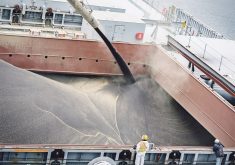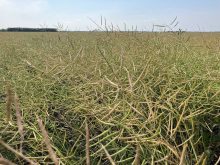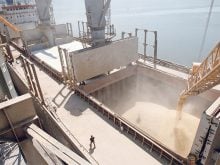SASKATOON — There are differing reports about what to expect from Canada’s top canola competitor this year.
Commonwealth Bank of Australia (CBA) is forecasting 8.27 million acres of the oilseed, a four per cent drop from last year.
Related stories:
- ‘Corrective bounce potential’ seen for canola
- ICE canola weekly outlook: Trends shift lower once again
However, it is dry in Western Australia, and if it remains that way over the next month, canola area could see “considerable” further declines, according to a recent report by the bank.
Read Also

Using artificial intelligence in agriculture starts with the right data
Good data is critical as the agriculture sector increasingly adopts new AI technology to drive efficiency, sustainability and trust across all levels of the value chain.
Western Australia accounted for 44 per cent of Australia’s 2023-24 canola production, so it is an important state.
New South Wales and Victoria are the other big producers.
Conditions in New South Wales look “phenomenal” heading into planting. Conditions are good in Victoria as well, but follow-up rain will be needed by June.
The Australian Bureau of Meteorology’s May-to-July rainfall outlook is calling for above average rainfall in New South Wales but below average in many parts of Victoria and Western Australia.
The bank believes the 2024-25 outlook is supportive for canola prices.
“If drought continues in Western Australia and Canada, ending stocks-to-use in key markets could be the lowest in eight years,” it said.
“We do expect support for prices.”
Commonwealth Bank is forecasting 5.67 million tonnes of Australian canola production in 2024-25, about the same as last year.
That forecast is at odds with one from the U.S. Department of Agriculture’s Foreign Agricultural Service (FAS), which calls for 6.5 million tonnes, a 14 per cent increase and the third largest crop in history.
The FAS believes planted acreage will be up due to more favourable price expectations than wheat and barley. It is forecasting 9.39 million acres, an 8.6 per cent increase over last year.
The FAS says soil moisture conditions in the canola growing regions are “broadly better” than last year and that the fall forecast calls for average rainfall as La Nina conditions ease to a neutral position.
For that reason, it believes yields will be 13 percent above the 10-year average. Exports are forecast at 5.1 million tonnes, a 700,000 tonne increase over 2023-24 levels.
Australia is the world’s second biggest canola exporter behind Canada.
Seventy per cent of its exports used to go to the European Union for biodiesel production, but in recent years there has been a “substantial shift” away from the EU toward Japan, the United Arab Emirates, Pakistan and Mexico, according to the FAS.
Marlene Boersch, managing partner of Mercantile Consulting Venture, said that is disturbing because those markets used to belong to Canada.
Ukraine is Canada’s other big competitor.
The FAS is forecasting 2.88 million acres of winter canola, a 15.4 per cent drop from the previous year. Another 800,000 acres will be planted in the spring, a 24 per cent increase.
It expects a crop of four million tonnes, which would be similar to last year.
Exports are forecast at 3.6 million tonnes, a 22 per cent increase. Almost all of that will be heading to the EU.
The EU’s canola production is forecast to be down 1.2 million tonnes compared to last year due to excess rain at planting and during the growing season, according to Commonwealth Bank.
The bank believes global demand for canola will continue to rise due in a large part to rapidly increasing U.S. renewable diesel production.
The crop is also benefiting from a shift away from competing biofuel feedstocks in the EU.
“Moving forward, canola should be a beneficiary of stringent EU restrictions on alternative feedstocks and simple lack of availability of others,” stated the report.
Specifically, it expects a reduction in the supply of palm oil and used cooking oil.
Mexico is also expected to be a big buyer in 2024-25. FAS is forecasting 1.4 million tonnes of imports, a 17 per cent year-on-year increase.
There will be strong demand for canola meal from Mexico’s poultry and swine sectors due to its price competitiveness as an alternative animal feed protein source.
“As for the food industry, demand for canola oil is forecast two percent higher year-on-year,” said the FAS.
Canada will be the largest supplier of canola to Mexico, but Australia is closing the gap in that market due to price competitiveness.
Another bullish market factor is that China’s piglet prices have risen 65 percent since the start of the year, indicating a rebuild of the hog herd.
China is trying to decrease its reliance on imported soybeans, so that could mean more canola meal in hog rations.
Boersch wonders why Canada’s exports have been so lacklustre if global demand is so robust.
Canada shipped out 4.24 million tonnes of the crop through week 36 of the 2023-24 marketing campaign, compared to 6.25 million tonnes the same time a year ago.
“That’s not strong export demand,” she said.
“It seems to me we haven’t been terribly competitive if you’re losing major market share into places like Japan, Mexico and Europe.”
Boersch is forecasting 6.5 million tonnes of exports for the entire year, which is well below the normal level of about eight million tonnes.
“Crush is saving us, but on exports we’ve done extremely poorly this year,” she said.
Commonwealth Bank said strong global demand and the potential for decreased supply in key export markets adds up to a bullish outlook for the oilseed.
It predicts that canola prices will remain constrained through the second and third quarters of 2024 as large volumes of South American soybeans and Southeast Asian palm oil keep a lid on the vegetable oil complex.
“However, moving into Q4 2024 and 2025, we expect global canola prices to rise,” said the bank.
“Global stocks in 2024-25 are expected to decline (by) 2.2 to 5.7 million tonnes.”
The FAS is also bullish on prices.
“The Winnipeg canola futures prices suggest a further strengthening of canola prices during 2024,” it stated in its report.
Boersch believes canola prices will be “relatively strong,” but a lot depends on what happens to U.S. soybean prices, and there are many unknowns on that front.
For instance, the USDA is forecasting 155 million tonnes of Brazilian soybean production, while Conab is at 147 million tonnes.
There are also big discrepancies between the USDA and China’s customs data on U.S. soybean exports to that country.
She said the soybean market is having trouble determining what direction it is heading.
“I don’t think it’s a foregone conclusion that it’s going to be a strong oilseed market,” said Boersch.
“And without any strength in soybeans, it is going to be very hard to have sustained strength in canola.”
Contact sean.pratt@producer.com
















